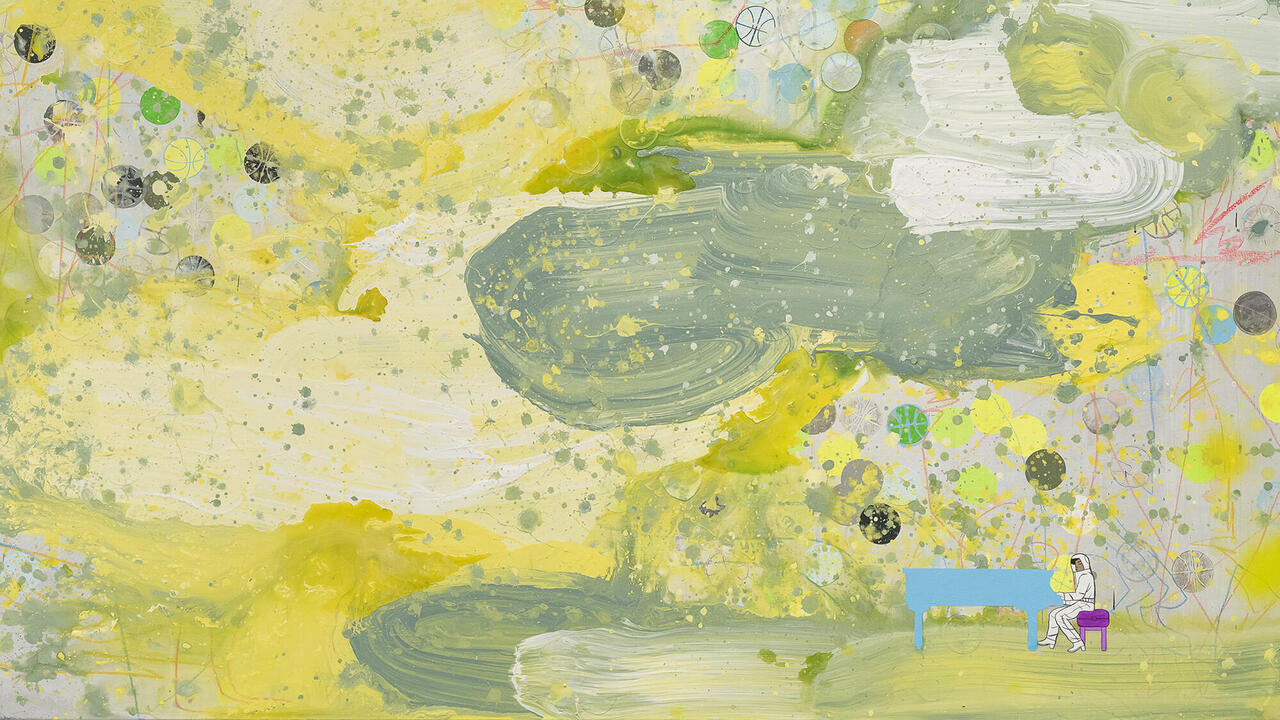Richard Wentworth's Thinking Aloud
A large sheet of blotting paper is framed on the wall. It is creased, having previously been folded into quarters. A drawing grips the middle of the sheet, running off the top and bottom edges: a framework of thick red pencil. One small section is scratched with black ink. As doodles go, it is an extraordinary monster and yet the context of its production makes it a thousand times more interesting: a pencil note reads 'Mr Lloyd George drew this during the meeting when the Terms of the Armistice were decided on. Versailles Nov 1918. Taken from his place by [war artist] Herbert A. Olivier afterwards'. Lloyd George's intense scribble is an astonishing object, yet it was only saved through the vision of an artist.
Robert Smithson knew that artists could 'make art by simply casting a glance', going on to complain that society cheats artists out of their 'art of looking' by only valuing 'art objects'. For this exhibition, Richard Wentworth has been sightseeing in the world of objects, gathering what he considers telling artefacts - a microscopic image of a firing brain cell; the patent drawing for Buckminster-Fuller's Geodesic Dome; a Romanian flag with the Socialist Republic's emblem ripped out during the 1989 revolution - in the hope that the viewer will see in them the same compelling qualities.
The title of the exhibition 'Richard Wentworth's Thinking Aloud', with its showbiz ring and double-meaning, is an odd one. But Wentworth's trademark lyricism is evident throughout the show, despite the fact that none of his own work is exhibited. But in truth, the entire project could be seen as an extended artwork. Perhaps all curators consider their shows to be meta-artworks, but this exhibition's extreme idiosyncrasies make such an opinion unavoidable.
Thankfully, this is not yet another attempt to resurrect the ready-made. Nor is it commodity Conceptualism or a didactic museum display. So what is it? An eclectic assortment of doodles, sketches, first draughts, patents, moulds, maps, weights and measures, photographs, documents, oddments, knick-knacks and artworks. The clue to why they have been together is in the title 'Thinking Aloud': to explore the initial formation of ideas and their eventual manifestation in reality. Or, as Wentworth puts it, 'how thoughts become ideas become realities', the process of progressive formalisation, from the fluidity of a thought-object to the absolute definition of a material object.
To this end we have Henry Beck's original 1931 sketch for the London Underground map and a 1936 preliminary draught of Pluto the Dog from the Disney studio. We have Percyval Tudor-Hart's original camouflage fabric samples from 1917 and a model by the Bilbao Guggenheim architect, Frank Gehry. We have Sir Edwin Lutyens' early sketch of the Cenotaph from 1919 and James Dyson's prototype vacuum cleaner (a hotrod cannibal of other Hoovers).
But then why do we also have Ceal Floyer's air-filled Garbage Bag (1996), Lucy Gunning's video Climbing Round my Room (1993) or Elizabeth Wright's oversized bicycle BSA Tour of Britain Racer Enlarged to 135% (1996-7)? The exhibition is paradoxical; Wentworth's stated aim is to explore the process of formalising informal ideas, but the curating wilfully drifts into new territories. The show is one of its own exhibits: a sketchbook of ideas, increasingly tangential as it joins dots under a shroud of poetic resonances.
Wentworth's unfettered enthusiasm for rambling anecdotes and obscure details has allowed his eye to run amok. As the intention was to set up a poetic dialogue between the objects, each shedding new light on the others, the show was always going to be demanding. But when its themes explode, you begin to wish for a larger show - one which could have included companions for those items that don't seem to know anyone else at the party: David Shrigley's hilarious Ignore this Building of 1998, Angus Fairhurst's 1991 transcript of Gallery Connections, the right-angled bird's nest...
'Richard Wentworth's Thinking Aloud' is a grand conception, aiming at an impossible combination of both fluidity and depth.
A review, like the catalogue, cannot do justice to the incredible range of objects on display - around 200 items. One subject, however, is explored in depth and dominates the exhibition: war. Having raided the Imperial War Museum's vaults, Wentworth has returned with sufficient objects to skew the emphasis of the exhibition. Not without good reason, for he recognises that the relationship between the military and the industrial, 'barely visible but infinitely affecting', is central to global life. If necessity is the mother of invention, then Wentworth seems to suggest that nothing breeds necessity like war.

















